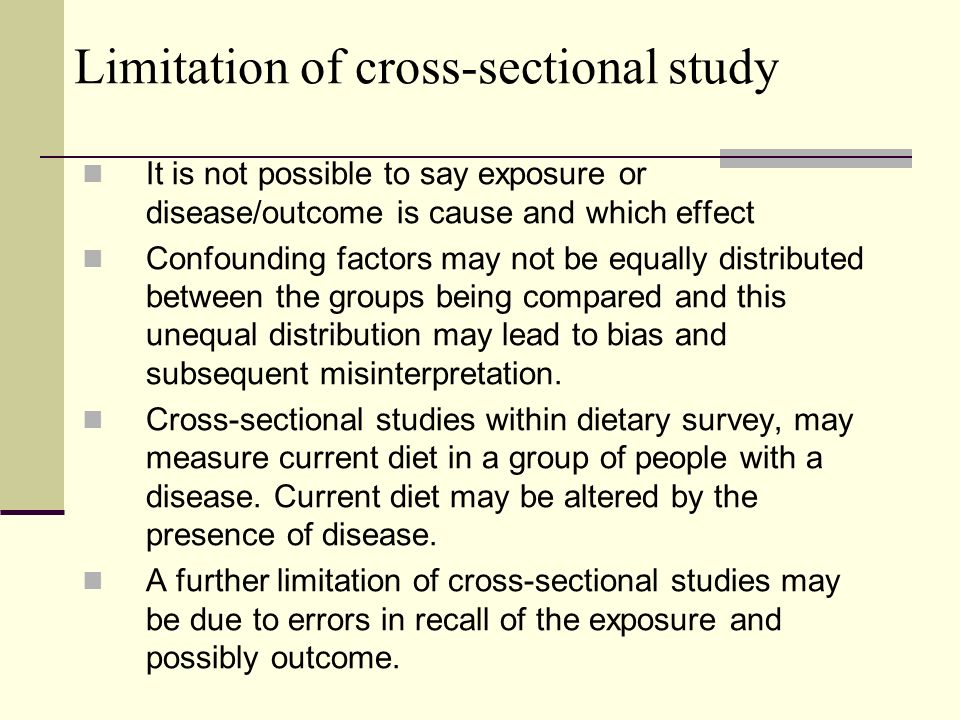Which of the Following Is a Limitation of Cross-sectional Research
The design that researchers use to study key transitions closely and make frequent observations is the. Limitations of a Cross-sectional Study.
B it does not provide evidence about change at the individual level.

. Longrtudinal stucdtes assess change in behavior over tme whereas cross-sectional studtes assess differences among groups of people. They are often used to measure the prevalence of health outcomes understand determinants of health and describe features of a population. Multiple Choice In a cross-sectional study that compares IQ scores the difference in IQ scores of 25-year-olds and 45-year-olds is due to the 45-year-olds having taken the same test at.
O chronology cannot be estimated obias from low response rates difficulties with sample recruitment extremely long and time consuming Question 23 2 pts A research article entitled Marijuana use in American Indian reservation communities. Study 2 is not a cross-sectional study. The primary limitation of cross-sectional studies is that the temporal link between the outcome and the exposure cannot be determined because both are examined at the same time.
For example we wish to study the relation between diet and exercise and being overweightobese. Distinguish between cross-sectional and longitudinal research methods. With a cross-sectional study it is impossible to determine whether the inability to.
A While the study will be able to show causation between age and the dependent variable it will not be able to show correlation. In a cross-sectional study that compares IQ scores the difference in IQ scores of 25-year-olds and 45-year-olds is due to differences in educational attainment. People in a group do not perceive themselves as part of a group The existence of a person in a group does not affect any other group member A group consists of two or more people who are interdependent M Which of the following describes a major lim.
10 For example in a zoo reproduction is found to be more commonly impaired in animals with stereotypies. There at the very least two limitations of a cross-sectional study. The benefit of a cross-sectional study design is that it allows researchers to compare many different variables at the same timeWe could for example look at age gender income and educational level in relation to walking and cholesterol levels with little or no additional cost.
In a cross-sectional study the researchers incur significant expenditure of time as he or she waits for the participants to get older. My Choice no sectional study the. The design that researchers use to recruit multiple age groups at a time but also.
Question 22 2 pts Which of the following is not a limitation of cross-sectional studies. Which of the following is a limitation of cross-sectional research. Moreover if the cross-sectional study is pure quantitative from my point of view follow-up qualitative research should follow to avoid the limitations and.
An infant is considered preterm if it is born before week. Limitations of cross-sectional studies 2 1 Not useful for studying rare exposuresoutcomes as have too few people to make estimate prevalence 2 Cant assess causation as both outcome and exposure are measured at a single point in time. When the data from a cross-sectional study is found useful for secondary data analysis the bias of the researchers can influence the information without any future realization.
Which of the following describes a major limitation of cross-sectional research. The first is that it only provides a static description of the research. Cross-sectional studies dont offer any control over purpose or choice.
Why cross sectional research design. 45 Which of the following describes a major limitation of cross-sectional research. Know the challenges and limitations of cross-sectional research Recognize what cross-sectional research studies are based on Explore some examples of cross-sectional research studies to.
In a cross-sectional study the participants may move or die before the. Since this is a 1-time measurement of exposure and outcome it is difficult to derive causal relationships from cross-sectional analysis. The design that researchers use to test many age groups at once in a relatively short period of time is the.
Provide an example of each. Bernice is planning to conduct a cross-sectional study for her dissertation. These studies are also prone to certain biases.
Since cross-sectional studies only study a single moment in time they cannot be used to analyze behavior over a period of time or establish long-term trends. The secondary approach has no control over how this work gets completed initially. Cross-sectional studies are observational studies that analyze data from a population at a single point in time.
People become test-wise from completing the same questionnaires multiple times Differences between age groups may be due to different experiences There is a high drop-out rate over the course of multi-year studies Children cannot complete questionnaires. C it can be threatened by practice effects and participant dropout. The timing of the cross-sectional snapshot may be unrepresentative of behavior of the group as a whole.
Which of the following is a greater issue in longitudinal and cross-sequential designs than for cross-sectional designs. See full answer below. Identify at least one advantage and one disadvantage of each type of method.
This is a prospective study following the growth rate of trees over time. Study 1 is not a cross-sectional study. A disadvantage of cross-sectional research is that A it is more inefficient and inconvenient than longitudinal research.
The difference between cross-sectional research methods and longitudinal research methods is that. Which of the following is a limitation that she and her advisor discuss before she begins to collect her data.

Cross Sectional Study Ppt Video Online Download


No comments for "Which of the Following Is a Limitation of Cross-sectional Research"
Post a Comment